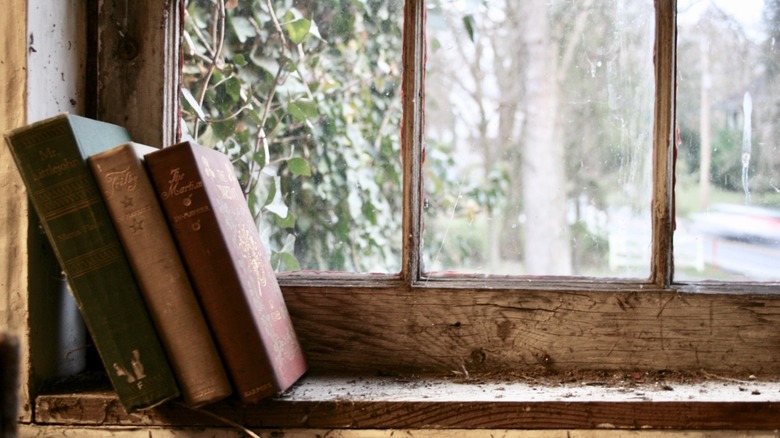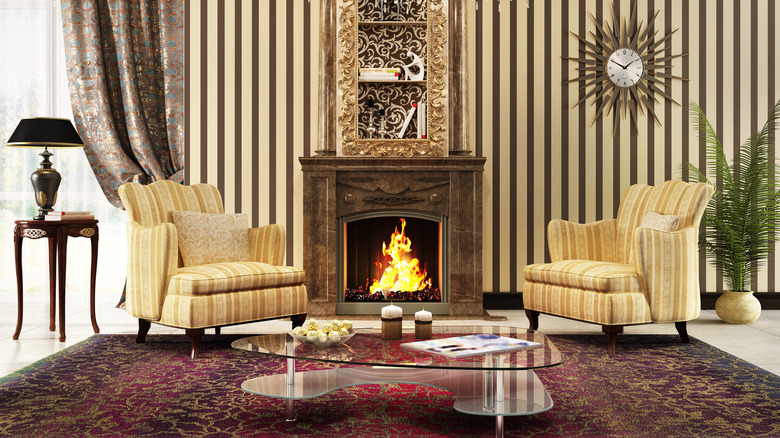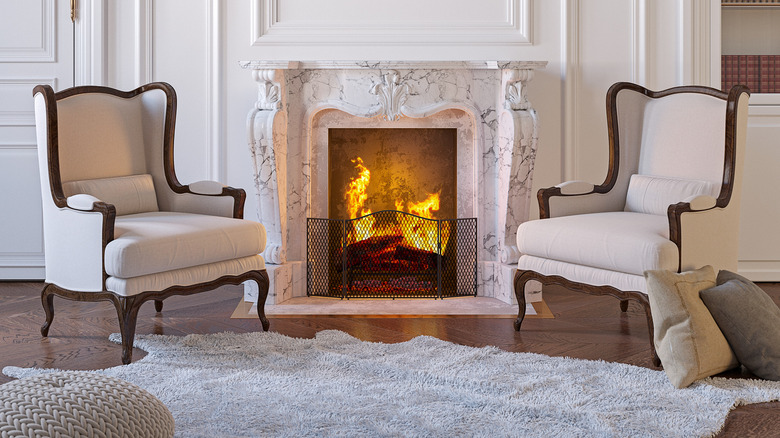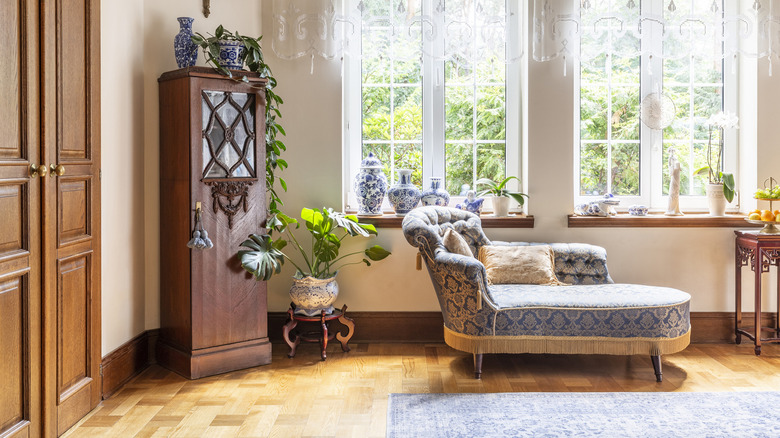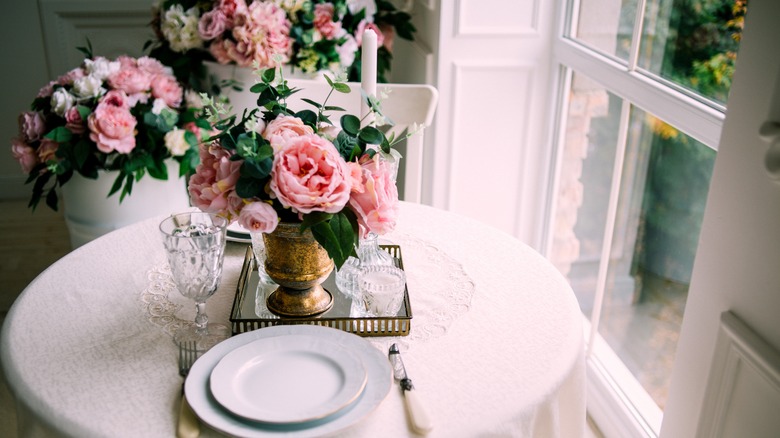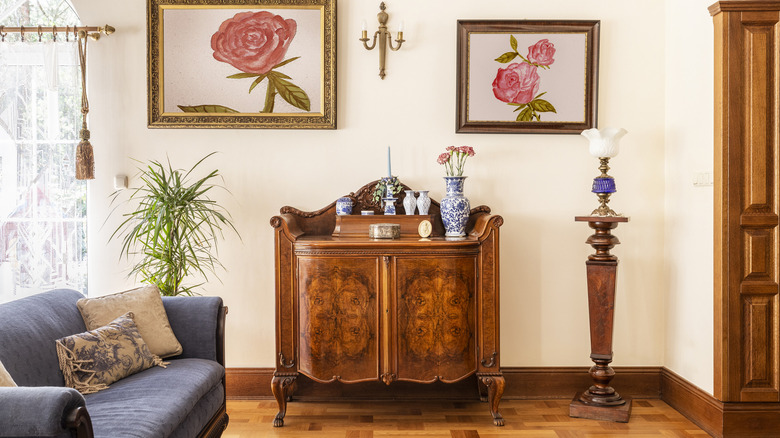5 Ways To Bring The Regencycore Style Into Your Home
Historic aesthetics are as timeless as they are stylish, which is why they remain popular among many designers and interior decorators. One burgeoning subcategory is regencycore, or simply Regency. Per Lilla Rugs, regencycore refers primarily to the Regency period of the 17th century and is a mix of historic opulence with quaint countryside, cottagecore influences.
A good example is any film adaptation based on the works of Jane Austen, including "Pride and Prejudice" and "Emma." The fan-favorite Netflix series "Bridgerton" also takes visual inspiration from the Regency period. Regency-era design was all about displaying wealth and regality, with dark and heavy woods, extravagant patterns, and showing off travel, arts, and culture (via Lux Review). Unlike other luxurious historic aesthetics, such as Rococo or the Gilded Age, regencycore is a little more subdued, with softer, naturalistic elements and seamless integration. You don't have to live in an English mansion to embrace aspects of Regency design in your own home, though. Keep reading to learn how to add touches of regencycore in your own design.
1. Regency stripe
The Regency period was in many ways an amalgamation of already existing trends, but there were a few distinct visual elements to arise from the short era. In terms of fashion, that would be the empire waistline. Something that engulfed both fashion and home design was the Regency stripe, which Lux Review defines as a vertical striped pattern, ideally in bold colors like green, red, and gold.
More specifically, the Regency stripe is wider than the traditional candy stripe, and originated in India as the Bengal stripe, per Artlandia. For a subtle approach, look for the wider stripe pattern in lighter, less contrasting powdery tones. A more traditional approach would probably include some sort of floral motif or other pattern, like this one from Loome Fine Furnishing Fabrics. This can be used as a bold wallpaper or to upholster a piece of furniture to give it that classic, regencycore look.
2. Marble
The official Regency period was quite short, only spanning from 1811 to 1820 as King George III's son acted as Regent ruler, later becoming King George IV (via JSTOR Daily). This means it quite easily blended in with the overlapping Georgian period, which lasted from 1714 to 1830, per O'Sullivan Antiques. One influence from Georgian decor that was also a staple of the Regency era was marble.
This time period saw a resurgence of classical decor and architecture, specifically with Roman and Greek influences, meaning marble made a major comeback. Furniture from this time period usually had marble tops or accents. Marble was also heavily featured in architectural design, including columns, molding, and fireplaces. A great way to add some regencycore flair to your home is with marble accents, but this can be very expensive. Instead, consider using a peel-and-stick marble vinyl or paper on tabletops, or even paint your own fake marble patterns by tracing lines with watered-down gray paint and blending them out using a sea sponge (via Crafted by the Hunts).
3. Pale and muted colors
Another thing to keep in mind when decorating in the regenycore style is your color palette. If you take a close look at how Regency fashion and décor are represented in film and television, you'll notice lots of pale and muted colors paired with rich wood tones. This is another aspect carried over from the Georgian period, which has a major emphasis on colors like sage, pea green, and rose, per Nazmiyal Collection.
Any color works well in Regency-inspired design, but just make sure you opt for lighter, paler, or at least flatter tones. For example, blues shouldn't be bright, royal, or cobalt shades, but instead either softer sky blues or deeper but flatter Prussian blue shades (via Sarah's History Place). The early Georgian period saw lots of deep, dark shades like brick and mauve, which were combined with lighter hues later on, so feel free to mix and match.
4. Floral touches
Large and luxurious flower arrangements were used to dress sets in Regency period dramas. Whether it's a captivating rose garden or some dried lavender hanging in the kitchen, you're sure to find flowers in anything regencycore. In fact, the Regency period saw the beginnings of floriography, otherwise known as the language of flowers, per Regency Reader. While this became much more popular in the following Victorian period, it got its start in the Regency era.
Simply arranging any assortment of flowers in a beautiful, ornate vase will give the room a signature Regency touch, but there were some favorite flowers of the time period. Some of the most popular include forget-me-nots, foxgloves, roses, and pansies (via Vanessa Riley's Regency Reflections). You could also bring in floral patterns through wallpaper, curtains, upholstery, rugs, and other textiles. Make sure not to do too much at once, though, and try to keep the colors muted and matching.
5. Antique wood furniture
Finally, a major staple in regencycore is furniture design and silhouettes. Almost all furniture was wood in the Georgian and Regency eras and had a very distinct style. According to Etons of Bath, the two most popular wood materials at the time were mahogany and oak. If you don't want furniture that looks too antique, at least look for wood that has that signature, reddish tone.
As for silhouettes, couch, chair, and table legs all tended to be very square-shaped and tapered toward the floor. Many also had a spadefoot at the bottom. The backs of chairs and couches were usually quite high, and the arms were curved and a little low. Chests, bookcases, desks, dressers, and other heavier pieces of furniture usually had standout brackets toward the floor, which would also typically have carved wood designs. Some popular wood-carving styles were cabriole, Marlborough, claw and ball, shell, and lion paw. Look for these features during your next antiquing session to add a Regency element to your home.
